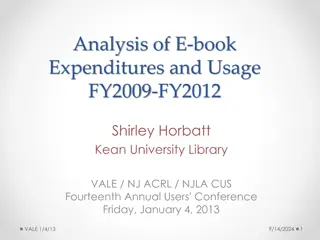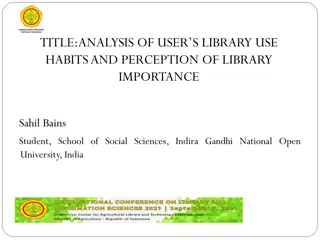Gwendolyn Brooks Library Usage Statistics with Springshares LibInsight
Gwendolyn Brooks Library utilizes LibInsight's E-Journals/Databases Dataset to streamline the collection and analysis of usage statistics for reporting to ACRL, IPEDs, and university administration. The tool offers various features such as storing login information, different levels of permissions, multiple data collection methods, COUNTER report integration, and cost analysis capabilities. While providing insights on setup, usage, and data analysis, the system presents both pros and cons for easy evaluation and management of library resources.
Download Presentation

Please find below an Image/Link to download the presentation.
The content on the website is provided AS IS for your information and personal use only. It may not be sold, licensed, or shared on other websites without obtaining consent from the author. Download presentation by click this link. If you encounter any issues during the download, it is possible that the publisher has removed the file from their server.
E N D
Presentation Transcript
Springshares LibInsight: E-Journals/Databases Dataset Joanna Kolendo GWENDOLYN BROOKS LIBRARY
Overview Gwendolyn Brooks Library collects usage statistics for reporting to ACRL, IPEDs, and the university administration. Traditionally this information was manually collected in Excel. This past year, GB Library investigated and began using LibInsight s E-Journals/Databases Dataset to input and analyze this data. (A newer version of this dataset is now available but will not be discussed here, as it s based on COUNTER5.)
The Basics: Springshares LibInsight Hosted system, supported, maintained, and updated by Springshare, this tool records and analyzes various library statistics and data points. Contains pre-designed dataset types, one of which is the e- journals/databases dataset.
E-Journals/Databases Dataset Stores login information Provides different levels of permissions for different users Allows for the collection of usage statistics at different levels: e-journals Databases Platforms (*might be dictated by automated COUNTER reports) Usage Data can be collected in the following ways: Manual entry Using spreadsheet in CSV or EXCEL formats; Supports specific COUNTER reports Harvesting data via SUSHI Provides cost analysis Cost data can be entered: Manually via Invoices Allows for uploading of license files Checks for duplicates
COUNTER COUNTER provides the Code of Practice that enables publishers and vendors to report usage of their electronic resources in a consistent way. (https://www.projectcounter.org/about/) Accepts automatic downloads of these specific COUNTER reports in CSV or Excel formats DB3 (Release 3) Total Searches and Sessions by Month and Service JR1 (Release 3 and 4) Number of Successful Full-Text Article Requests by Month and Journal PR1 (Release 4) Total Searches, Result Clicks and Record Views by Month and Platform DB1 (Release 4) Total Searches, Result Clicks and Record Views by Month and Database
Demo Dataset Set-up Usage Data Cost Data COUNTER uploads Examples of data collected Data Analysis
Pros & Cons: Lessons Learned Pros Downloading COUNTER reports Place to store all database information Easy of use Cons Only certain COUNTER reports are supported Easier to track databases by platform than by database because of the COUNTER reports supported (do not provide download numbers by database, but rather by platform)























